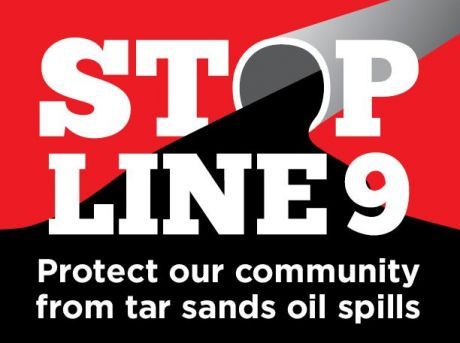Features
You are here
Stop Line 9, stop the Tar Sands

September 23, 2013
Without an environmental assessment, oil giant Enbridge wants to use a 38-year-old pipeline to pump toxic tar sands through the most populated corridor in the country—expanding tar sands production and oil spills, promoting climate change instead of green jobs, and undermining democracy and indigenous sovereignty.
Tar Sands
According to the Indigenous Environmental Network (IEN), “Northern Alberta is ground zero with over 20 corporations operating in the tar sands sacrifice zone, with expanded developments being planned. The cultural heritage, land, ecosystems and human health of First Nation communities including the Mikisew Cree First Nation, Athabasca Chipewyan First Nation, Fort McMurray First Nation, Fort McKay Cree Nation, Beaver Lake Cree First Nation, Chipewyan Prairie First Nation, and the Metis, are being sacrificed for oil money in what has been termed a ‘slow industrial genocide.’ Infrastructure projects linked to the tar sands expansion such as the Enbridge Northern Gateway pipeline and the Keystone XL pipeline, threaten First Nation communities in British Columbia, Canada and American Indian communities throughout the United States.”
In addition to threatening indigenous communities, the Tar Sands are Canada’s fastest growing source of carbon emissions. This year, for the first time in human history, atmospheric concentrations of carbon dioxide reached 400ppm. In this context we’re seeing increasing climate disasters such as hurricane Sandy and the epic floods in Alberta and Toronto.
Line 9
Despite this, oil giant Enbridge wants to use a 38-year-old pipeline, Line 9, to pump tar sands oil eastwards from Sarnia through Toronto to Montreal. Even if Line 9 doesn’t spill, it will increase tar sands production and global carbon emissions.
But the reality is that tar sands pipelines spill all the time—like Enbridge’s 2010 spill into the Kalamazoo River, the massive 2010 spill in Lubicon territory, Enbridge’s 2011 spill in the Northwest Territories, the 2013 spill that sent tar sands and the toxic chemicals used to make it flow in pipelines through a residential neighbourhood in Arkansas, and Enbridge’s 2013 spill in Alberta. These bitumen spills can’t just be “cleaned up” because some components evaporate and poison the air while others sink and poison the earth and water. After three years and a billion dollars in cleanup fees, the Kalamazoo River is still contaminated.
A spill from Line 9 could poison First Nations land it crosses, major waterways that carry drinking water, and towns and cities, including Toronto. Of course, the pipeline does not pass along Bay Street, but it does cut through the poor and racialized neighbourhood of Jane and Finch.
Indigenous sovereignty and green jobs
There’s been an outpouring of opposition against the Tar Sands and its pipelines, driven by the communities most affected. As IEN states, “Just a few years ago, people in Canada, U.S. and Europe heard little to nothing about the Canadian tar sands. Today, the tar sands have become a topic of national and international discussion as stories of cancer epidemics in the community of Fort Chipewyan, massive wildlife losses related to toxic contamination, environmental degradation and increased vocal resistance from impacted communities have shattered the ‘everything is fine’ myth propagated by the Canadian and Alberta governments.”
The climate justice movement increasingly includes the labour movement. Line 9 will only produce a few temporary jobs in an industry that exposes workers to toxic chemicals while undermining the environment on which our future jobs depend. As an organizer from the Canadian Autoworkers said last year in the lead up to the Defend Our Coast sit-in in Victoria, “Tens of thousands of unionized and other jobs depend on healthy river and ocean ecosystems. We will be standing in solidarity with thousands of working people in BC and our First Nations sisters and brothers.”
Democracy
In an attempt to undermine opposition, Harper has scrapped environmental regulation. There has been no environmental assessment for Line 9, and Enbridge has given “donations” to municipalities along the route (including the Hamilton police, who arrested Line 9 protestors for occupying a pumping station). The National Energy Board (which the Harper government has called an “ally”) has excluded people from contributing to hearings and tried to divide the movement between those they allow at hearings and those they do not allow, all while monopolizing decision-making power. Meanwhile there has been no free, prior and informed consent from First Nations for Line 9 or the Tar Sands.
But this hasn’t stopped massive opposition against the Northern Gateway pipeline west, and the Keystone XL pipeline south. These movements—uniting indigenous, environmental and labour activists—have been models for the emerging movement against Line 9. In October the National Energy Board is holding its hearings in Toronto, and many opposed to Line 9 will present their case inside. Adding to their voices will be a rally outside, on Saturday, October 19, to say “No Line 9, No tar sands pipelines!”
Join the rally in Toronto on Saturday, October 19 at noon outside the Metro Convention Centre.
Section:










